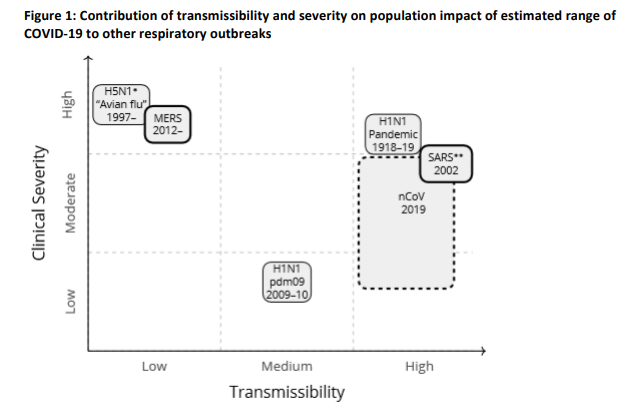Trial and Error: What SARS-CoV-2 and COVID 19 Exit Planning have in common
The SARS-CoV-2 virus is the latest pandemic virus to have blighted us. The process of genetic trial and error created yet another exceptionally potent pathogen. As strong social distancing measures are clearly succeeding at ‘flattening the curve’, economic recovery is re-emerging in the narrative. The outlook hangs on varying beliefs relating to vaccine development and other speculative matters. Nonetheless, our path to economic recovery we will benefit from trial and error on the part of world leaders. This will be helpful for markets.
Genetic trial and error produced a monster
SARS-CoV-2 is the most recent pandemic virus to emerge from persistent re-ordering of genetic code. There are already thought to be eight strains in circulation. The process of continually trying the effectiveness of new genetic combinations will almost inevitably identify something which will be successful given enough time.
In this case, random mutations created viral properties which had an effective blend of virulence and transmissibility. This has made SARS-CoV-2 the most dangerous virus for humanity since the Spanish Flu (H1N1). Specifically, the virus keeps enough hosts alive and well enough to spread it widely so the number of potential deaths is very high:

Source: Australian Government Department of Health
Curves, one lump or two?
The world has become accustomed to the idea of an infection curve. Fortunately, strong social distancing measures appear to have met with success, much more so than had been feared during the initial planning phases . As peak infection rates have been reached in Australia, and are anticipated in the coming weeks for other developed countries, the narrative has already given much more space to the idea of economic recovery.
Plotting the economic recovery requires some means to estimate the way in which social distancing measures will be wound back. Markets require an estimate of what industries will re-open and the time frame over which this will occur.
One influential development would be the availability of an effective vaccine. As this screenshot from Google shows, taken at the time of writing, opinions vary on the matter:

Epidemiologists generally believe that flattening the curve is the beginning of a drawn out process. They believe relaxation of social distancing measures without appropriate measures to prevent a strong re-emergence would largely result in nothing other than delaying the infection curve.
Whilst each community may come to its own conclusion as to the worth of a life in economic terms, there are basic requirements which regulate the rate at which economic normalisation can take place:
- Widespread availability of reliable testing at scale;
- Ability to case trace any positive test results rapidly;
- Medical capacity to absorb those becoming inflected;
- Effective anti-viral treatments to reduce the severity of infection; and
- The development of an effective vaccine.
As the screenshot implies, many of the above measures are being worked on, yet the time frame and effectiveness of these is currently speculative as a whole.
Social Distancing: what level is right?
One aspect which is under the control of policy makers is the social distancing measures in place. From the case count in Australia, it appears that our current measures are more than sufficient to reduce the reproduction rate of the virus below 1, inferring that it should eventually burn itself out. Although the decision has been made to maintain the current settings for now, in order to reduce the number of infected people in circulation, it is hard to know when and how to relax these settings.
Early estimates of the effectiveness of social distancing were lower than what has transpired. However, far from implying criticism of our modellers, this highlights the impact of model uncertainties and our evolving knowledge of the virus. It also highlights the complexities associated with non-linear dynamic models in these settings. These models are given the unenviable task of guessing how a virus might spread in a situation which has never been observed before, where small differences in assumptions can have large impacts.
The economic costs of maintaining the current social distancing regimes are very high. Despite the uncertainties, the incentives to resume some former level of social interaction will likely lead to experiments in relation to what is feasible.
China has now opened much of Wuhan and the country’s economic activity has picked up again. Singapore, which successfully contained its first wave under a relatively mild DORSCON Orange setting, encountered a second viral break-out. Japan bubbled along and has now announced a State of Emergency. The US, along with Italy and Spain, are examples of poor management. They will remind us of what we have to lose.
What progression will Australia follow?
Less guesswork, more direct observation
Our efforts will be informed from the above examples. However, they will also be enriched by those arriving soon:
· Denmark has announced that children aged under 11 will return to schools and nurseries. Norway is planning to do the same ; and
· In Austria, some smaller shops will re-open soon and restaurants and hotels are scheduled to open next month.
In relation to schools, the implementations planned in Denmark and Norway add to evidence developing in Taiwan and China. Closing schools is a highly controversial policy. The associated economic costs are large due to the amount of workforce productivity lost to take care of children. The economic impact of closing schools for three months would equate to 1% of GDP alone .
In Australia, the choice to do so was at least partially taken away from the health advisers by concerned parents removing the children against advice. A sober analysis of the known evidence would suggest that a different choice might have been made . We will soon have more live evidence on which to base decisions.
If offices and shops can gingerly re-open, it has a significant impact. Retail sales, let alone services, make up approximately 15% of GDP and have been sharply curtailed.
More live examples of different policy measures will be directly observable and reduce the model uncertainties considerably. This will mean that the margins for error may be reduced and a more optimal path towards normality can be found collectively.
Australia has had the benefit of not entirely closing its building and construction industry. In other words, we know that we can function as we have with those industries still active, which were shut in other jurisdictions, and still contain the virus as a whole. Might more be possible? Might non-essential manufacturing activity re-open safely enough?
Policy trial and error will lead us out
Groups in Germany and the US have released planning documents which may guide thinking about the path towards normality. Australia will shortly receive a plan from the health officials which will need to be considered alongside the economic implications.
Prime Minister Scott Morrison, who has ruled out the aim of completely eliminating COVID-19 , has opened the way for states to commence their own process of trial and error. As is the case for international economic competition, decisions made by the states may also be economically motivated. The economic tension is re-emerging.
This type of informed and motivated pattern search is the policy equivalent of trying different genetic codes. By deliberately creating a variety of responses, and learning quickly from them, we can find out which works much more quickly. Naturally, care needs to be taken as the unique consequences of each jurisdiction must be considered.
Whilst we do not know when a vaccine may become available, the path towards re-opening schools, manufacturing, retail shops and restaurants will shortly be tested further and add to a growing body of evidence. The economic consequences for these are very large. Investors should keep an eye on these developments. They are likely to provide a better guide for the time being than speculations on Hydroxychloroquine or the date a vaccine might become available.
References:
https://www.pm.gov.au/media/press-conference-australian-parliament-house-6
Murray A; 12 April 2020; “Coronavirus: Why Denmark is taking steps to open up again”; Reuters
Lempel H, Epstein JM and Hammond RA; 2009; “Economic Cost and Health Care Workforce Effects of School Closures in the US”; PLoS Currents
Sadique MZ, Adams EJ and Edmunds WJ; 2008; “Estimating the costs of school closure for mitigating an influenza pandemic”; BMC Public Health
Viner RM et al; 6 April 2020; “School closure and management practices during coronavirus outbreaks including COVID-19: a rapid systematic review”, Lancet
AHPPC statement 3 April 2020 relating to Early Childhood and Learning Centres
Grattan M; 7 April 2020; “Scott Morrison indicates ‘eliminating’ COVID-19 would come at too high a cost”; The Conversation
Disclaimer: This document should be regarded as general information only rather than advice. In preparing this document, no account was taken of the investment objectives, financial situation or particular needs of any individual person. Any opinions expressed in this document are the author’s alone and may be subject to change. The information must not be used by recipients as a substitute for the exercise of their own judgment and investigation
2 topics

